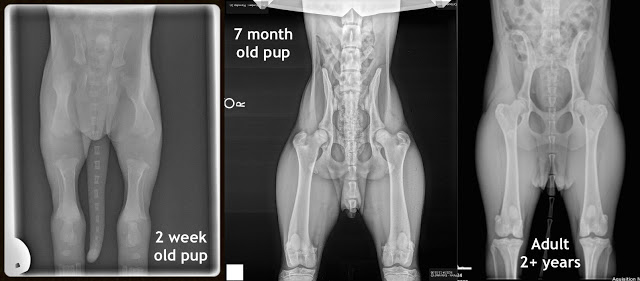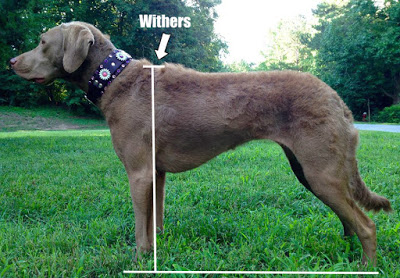There is a lot of discussion about the size of a mobility dog necessary for clients who need them for certain tasks. I found this article to be very informative, and would welcome any other suggestions on good articles regarding this:
The job description of a mobility dog can include a myriad of things. Wheelchair pulling, button pushing, flipping light switches, counter balance, bracing, item retrieval, door opening and closing and momentum pulling, just to name a few. Whatever mobility tasks a service dog is trained to do are things they should be more than physically competent to perform.
For example: an 8 lb Papillon can do light item retrieval (keys, medicine) and may be able to operate a K9 phone, certain adapted light switches, open lower, lightweight doors, but they are in no way capable of pulling a wheelchair.
Another example: a 58 lb Chesapeake Bay Retriever (I’m using Saxon in this example!) can easily tug doors, turn on/off lights, press handicapped buttons, counterbalance, item retrieval and momentum pull, but is NOT capable of bracing. I will never ask her to learn to square up or stiffen her body for bracing. She will never be large enough to support the weight I carry.
Yet another example: a 90 lb Doberman can easily do most if not all mobility tasks that could be required, including bracing. A 90 lb dog will be large enough for most adults who are of average or overweight (NOT obese) size to do brace work with.
For this post I’m not mentioning program trained mobility dogs because they generally come with their own set of trained tasks, health check up, mobility harness/gear with usage instructions and have been chosen specifically for the client. The following questions are geared at those people who have mobility issues, either diagnosed or self assessed (symptoms can still impede your overall mobility) and decide to train a mobility dog for themselves.
What mobility tasks can you not live without?

There are many mobility harness makers, several of them making custom harnesses to the dog’s specifications. Unless you can go to the harness maker’s store front to have your dog measured personally, the handler is often left to get their dog’s own measurements. A proper rigid bracing harness consists of a a piece of metal that runs horizontally across the shoulders NOT vertically up the spine. The strongest point on dog to bare weight is right across the shoulders. When bracing on the shoulders it is imperative the dog be taught to square up and brace to minimize likelihood of injury for both dog and handler.
Prior to putting on any rigid handled harness, the dog must have already mastered squaring up and tensing up muscles prior. Training a mobility dog, contrary to some things I’ve seen floating around, is not as simple as throwing a harness over their head, buckling it up and just walking with it. The dog does not automatically know what to simply because they are now wearing a mobility harness. What I mean by this is the dog stands with both of their front feet together so the shoulders line up. The back feet are in line with the shoulders and are also square (not one significantly forward or backward). From this position the dog has the best ability to brace themselves effectively. I am using the word “Brace”, but whatever you call it (“Stiff” “Hold” “Steady”) the behavior is the same. The dog who has now mastered squaring their body will now need to learn how to stiffen their muscles in response to pressure being applied. This is NOT a behavior that can be introduced, learned and proofed in a single training session. This behavior also should NEVER be taught with a mobility harness. The harness should be added later once the brace behavior is solid.
Handle height is important. The proper way to measure for handle height is for you to up as straight as you can with your arms hanging loose at your side. Whichever side your dog heels on, make a loose fist with that hand. That is the height your mobility handle needs to be. Your shoulder should not raise to extend your arm nor should you be able to bend your elbow while holding the handle. When measuring for a handle you will stand as straight as you can, let your arm hang and hold it as if you are gripping a bar. It may actually help to hold a pen or marker while you are measuring from the distance from your hand to the floor. The other number needed to get a handle height is the dog’s height. My dog is 23″ at the shoulder. The height from my relaxed arm with a closed fist to the floor is 30″. Therefore I would need a handle height of 7″.
It is not advised to do mobility with a dog for which you would require greater than a 6″ handle. Although there are harness makers that will add handles of heights as high as 14″, that is too high, and a dog can far more easily get harmed with the same action and force with a 10″ rigid handle vs a 4″ one. When a handle is too high too much pressure (such as a full force brace) or an incorrect brace (where the dog is not squared and the handler may not be completely next to or parallel to the dog and handle) it creates something called torque. Torque for those who aren’t mechanics or into physics, is defined as: a twisting force that tends to cause rotation.
Naturally any twisting force repeatedly applied to the spine and shoulders of a dog of any size is as dangerous as it sounds. Since to my knowledge none of the rigid handle harnesses on the market come with a detailed instruction manual including safe, proper usage, the handler/owner of their service dog’s new harness must now choose between trying to figure out what to do on their own or rely on the sometimes misguided advice of trainers or the internet. Bracing as carried out ideally will have the handler cue to the dog to stop or the dog auto stops. The handler asks the dog to square up if the dog has not already done so. The handler puts pressure on the handle to lever themselves up, usually from lower to higher ground (curb or stair) or from seated to rising such as standing from a chair. The dog remains still with muscles stiffened while the handler has hands on the handle. This is momentary pressure. The dog’s back is not meant to sustain the prolonged pressure of an adult’s body weight.
A dog should not be asked to brace while they are standing. The handle may be used for steadying purposes, such as reaching out to hold it or reorient in space, but at that point it is unsafe to apply any weight or downward force as the dog is not squared or prepared to brace. A rigid handle should not be used as a crutch or cane. Even a dog large enough to handle temporary bracing should not be subjected to step by step partial or full adult weight with downward force. If every step needs physical support above steadying simply by way of the handle simply being held, another mobility aid (cane, crutch, walker) may need to be added so the dog’s safety can be ensured.
On the note of discussing bracing in motion, a dog cannot square their body in motion, so bracing with a handle of any height cannot and should not be done in motion. The handle is NEVER meant to be pushed forward or backward. It is NOT a guide handle. There are a multitude of other harnesses that have guiding handles or pull straps if that is what is needed. There are also harness makers who combine a mobility harness with a rigid handle with a guide handle or pull strap attached so the harness can serve both functions.
One thing I see frequently in some of the service dog gear groups targeted toward mobility harnesses is that people will buy a rigid handle thinking they need it or that their disability manifests itself far more physically than it actually does. I see a lot of people trying desperately to downgrade their rigid handle for a soft handled balance harness. One of the only real differences between a rigid handle and a non rigid one is that a non rigid handle cannot be used for bracing at all. It can however be pulled up on to help yourself up or to hold the handle while the dog leans the opposite way, providing momentum to help you right yourself. A non rigid can double as a leading harness and can be used for momentum pulling and counter balance.
With one final comment, if you require an 85 lb dog, a dog who would at peak fitness be 70 lbs should not be used because it weighs at or in excess of the necessary 85 lbs. A dog who carries a good deal of excess weight should not be used as a mobility dog. There is simply no selfless way to ask a dog, even a trained dog, to support your weight and many multiple excess pounds of their own. I’m not talking a 3-5 lbs too many. There are so many dogs I’ve seen who weigh probably 20-30 lbs overweight, and I’ve seen some who may even be 40+ lbs overweight working as bracing mobility dogs. It’s just not fair. After a diet if they are healthy and fit (and evaluated by a vet to be cleared after a large weight loss) sure, but until then, the dog doesn’t need to carry more than his own share of weight and yours too.
Source: Physical Fitness and Safety with Mobility Service Dogs ~ The Dogsider



